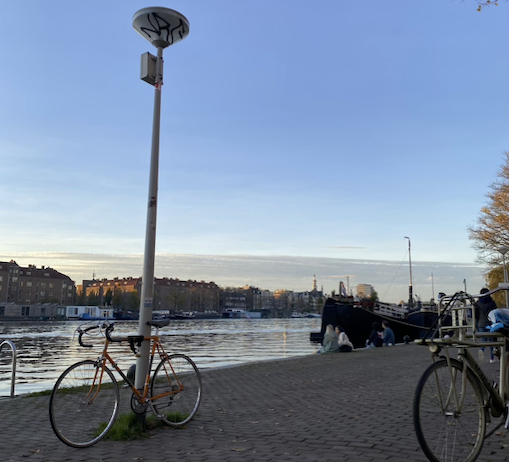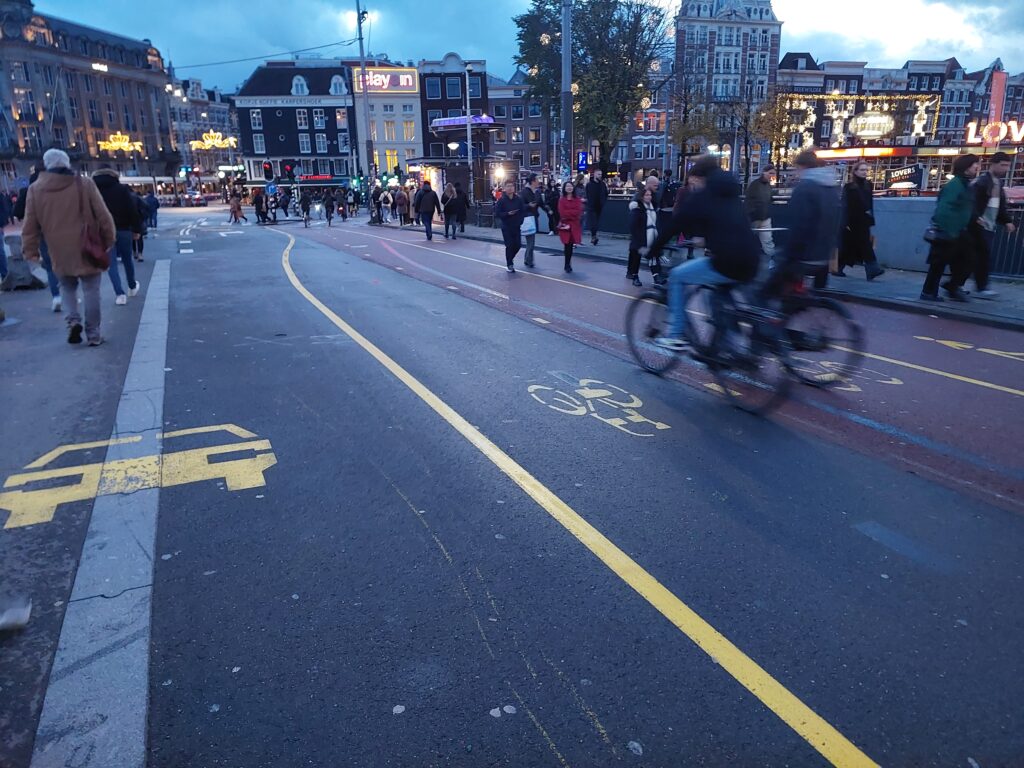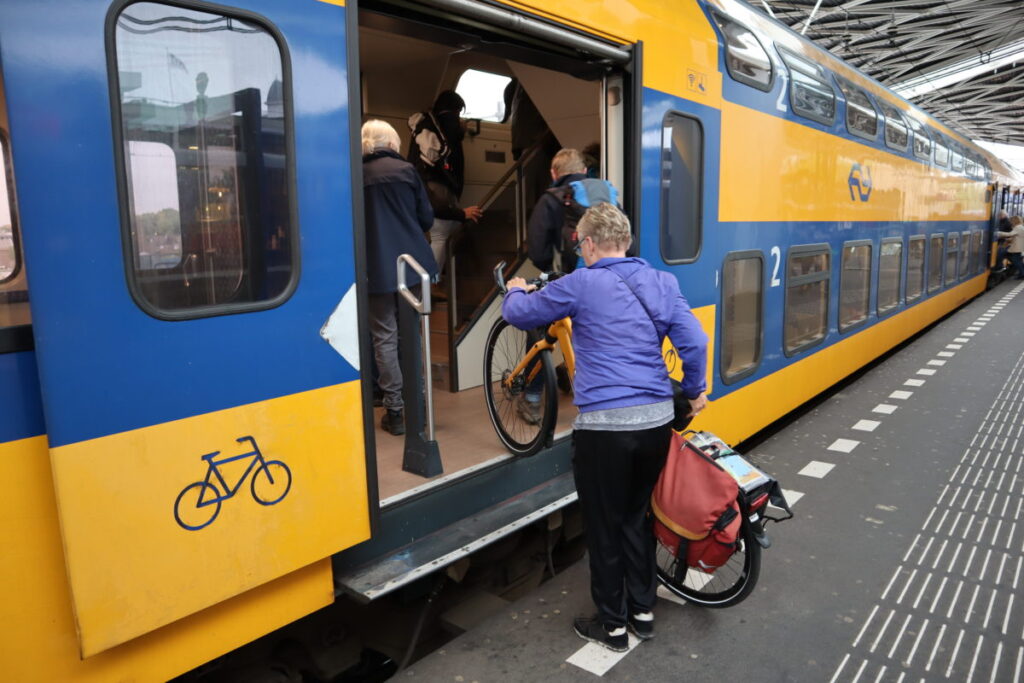Benoit Cuvier | LinkedIn
Selected final essay, published 21st May 2023
Benoît is a Cycling Education Programme Manager working for a local authority in the South West of England. He has a Bachelor Degree in Cultural Events Management from the University of Poitiers. For him, nothing is more rewarding than delivering socio/economic/ecological values via inclusive active travel schemes.
Unravelling the Cycling City MOOC on Coursera

This essay highlights my learning from the online course: ‘Unraveling the Cycling City’ from the University of Amsterdam(1). I also focused my reflection on my belief that cycling is a perfect urban degrowth tool. The term ‘degrowth’ is used for an economic, environmental and social movement that points out the socio-ecological harm caused by the pursuit of infinite growth. It emphasizes the need to globally reduce extrativism/production/consumption, and advocates a socially just and ecologically sustainable society. A downsized Gross Domestic Product (GDP) doesn’t mean that population well-being will decrease, on the contrary, we know for sure that after a certain level of GDP per capita, economic growth is not correlated with happiness indicators. For instance, Denmark has a relatively small GDP compared to other developed countries but its population is considered among the happiest people on this planet(2). This is a relevant example for this essay because after the Dutch, Danes are the ones who cycle the most(3)! Now that you might understand we need to apply degrowth policies – especially in the global north – I can share my key takeaways from the course to demonstrate how cycling is a great mobility tool to contribute to a prosperous urban life within our planetary boundaries.

When studying the historical perspective of why the Dutch have the most mature cycling system in the world, one reason – among others – was the oil crisis in 1973 that prompts the government to develop cycling policies in order to reduce the nation’s energy consumption(4) (it is interesting to note that the book ‘The limits to Growth’(5) was published only one year before, in 1972). The Dutch case is not unique, other national cycling policies already exist in favour of degrowth. For instance, when the counter movement came, Danish policymakers quickly integrated the grass-roots activism in their traffic plans, and since the 1990s, they have been at the forefront in promoting the bicycle as part of its environmental and energy policies(6). More recently, a committee of climate change experts have told the Irish Government that it needs to make hard choices to meet its own targets on emissions reductions, and recommended to place a stringent annual limit on the use of fossil fuels in the economy, and ration it out in a way that protects fairness and justice(7).
It was also fascinating to learn from the course that land-use measures have the huge potential to limit the growth of transport. This perspective also made me think European countries are luckily placed to implement such degrowth initiatives because most historic cities still function with walking/cycling environments. According to Luca Beronili ‘average travel distances of motorized transport, have been increasing (…) resulting in a 31% growth of the per capita distance travelled by car between 1990 and 1997. This takes us back to the need to significantly increase the share of public transport in the longer trips, or to limit the growth of average distances through land-use measures(8).’
Social issues are also intrinsically linked to the ecological situation and policymakers should always keep in mind the triple bottom line 3Ps model(9): Planet, People, Profit, to ensure values are created in all forms of capital. It was insightful to hear Leo Bormans saying that cities have been built as market places to meet each other but relationships between citizens have been replaced by consumerism, with people driving in the city just to buy things. As cycling increases human interactions and social capital – converting traffic space to public space – local authorities put more and more priority on micro-mobility policies(10).

With a world’s population expected to increase by 2 billion persons in the next 30 years, cycling is a powerful degrowth tool to address the environmental emergency and the need for more social justice. Developed at the speed and scale, cities with a strong cycling system and culture would on one hand, significantly reduce air pollution and carbon emissions (e.g. a bicycle lifecycle is 93% lower than a car in terms of CO2 per travelled km(11)), decrease energy demand from a reduced production, consumption, and distribution, which will eventually cut mineral extraction activities. On the other hand, it would boost social capital, improve population well-being, and re-localise economic activities. There is still an unanswered question that I wish to explore: should we cap the production of e-bikes to balance environmental externalities with the benefits of this technology (e.g. it increases senior cycling rates(12))?
Last but not least, degrowth emphasises the importance of self-organization and the movement has often a strong association with the ultra-democratic political philosophy Anarchism(13). The resemblance with the unexplained effectiveness of cyclists’ self-organisation is striking. I would like to conclude with Marco te Brömmelstroet’s words: ‘do we want to engineer our cities for flocks of geese or do we want to design our cities for swarms of starlings?(14)’.

Sources in Chronological Order:
- MOOC unravelling the cycling city, University of Amsterdam
- Alexandra K, 2020, ‘Danes are the second happiest people in the world’, Copenhagen Capacity
- Kuipers G, 2012,‘The rise and decline of national habitus: Dutch cycling culture and the shaping of national similarity’, page 25, course material week 1, MOOC unravelling the cycling city, University of Amsterdam.
- BicycleDutch, 2011, ‘How the Dutch got their cycle paths’
- The Limits to Growth, Wikipedia
- Oldenziel, Ruth, and Adri A. de la Bruhèze, 2011, ‘Contested Spaces: Bicycle Lanes in Urban Europe, 1900-1995.’, page 41, course material week 1, MOOC unravelling the cycling city, University of Amsterdam.
- McGee H, 2022, ‘Rationing fossil fuels among hard choices Government needs to make, committee told’, The Irish Times
- Luca Beronili L, 2002, ‘Urban development without more mobility by car? Lessons from Amsterdam, a multimodal urban region’, page 585/586, course material week 2, MOOC unravelling the cycling city, University of Amsterdam.
- Triple bottom line, Wikipedia
- Bormans L, video 13:07, course material week 4, MOOC unravelling the cycling city, University of Amsterdam.
- WRI ross center for sustainable cities, 2021, ‘Cycling is sustainable economic development policy’, Twitter
- Walljasper J, 2018, ‘Would an E-Bike Get You Pedaling?’, Getting Around
- Anarchism, Wikipedia
- Te Brömmelstroet M, ‘The Handicap of a Head Start’, course material week 4, MOOC unravelling the cycling city, University of Amsterdam
- (Figure.1) Te Brömmelstroet M, Nello-Deakin S, Quillien J, Bhattacharya I, 2018, ‘Towards a pattern language for cycling environments: merging variables and narratives’, page 41, course material week 4, MOOC unravelling the cycling city, University of Amsterdam.
- (Figure.2) Oldenziel, Ruth, and Adri A. de la Bruhèze, ‘Contested Spaces: Bicycle Lanes in Urban Europe, 1900-1995.’ page 32, course material week 1, MOOC unravelling the cycling city, University of Amsterdam.
- (Figure.3) Kager R, Harms L, 2017, ‘Synergies from Improved Cycling-Transit Integration Towards an integrated urban mobility system’, figure 6, course material week 1, MOOC unravelling the cycling city, University of Amsterdam, Urban Cycling Institute
- (Figure.4) Colville-Andersen, M 2019, ‘The Arrogance of Space’, colvilleandersen.medium.com



